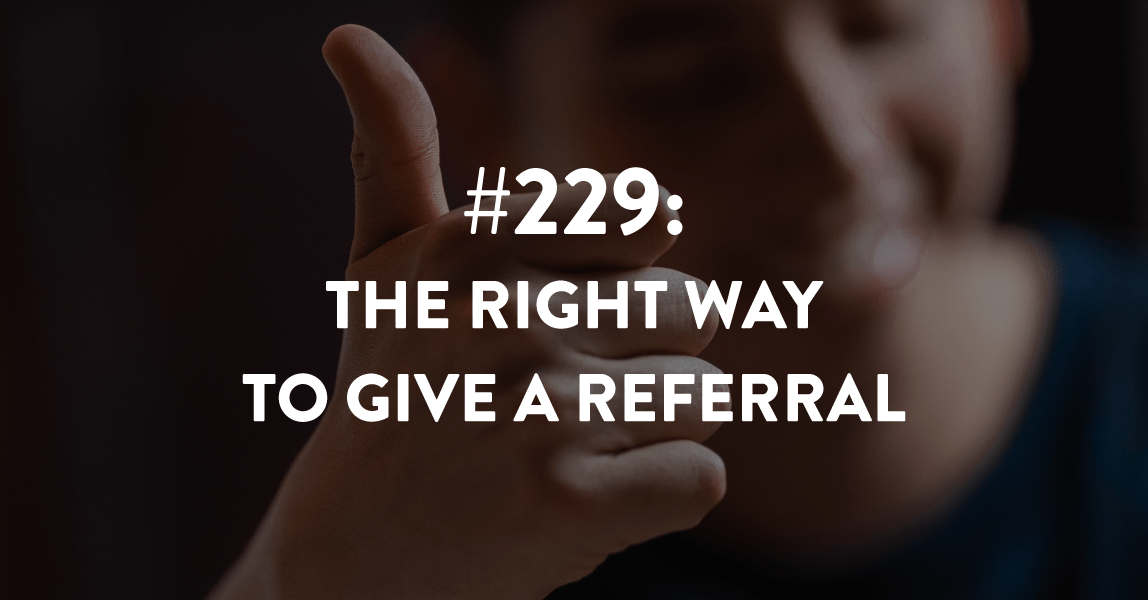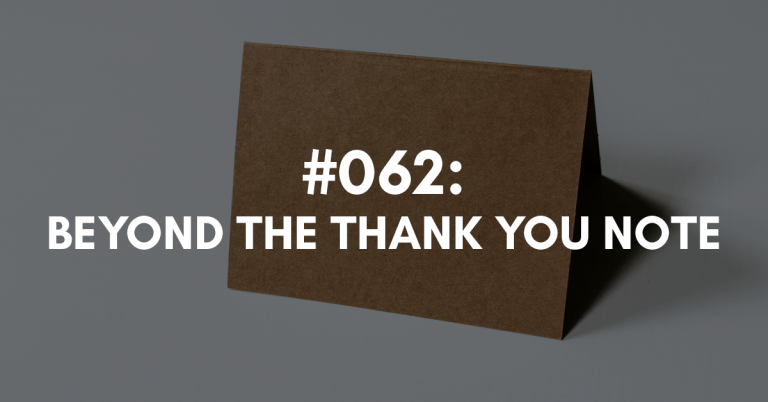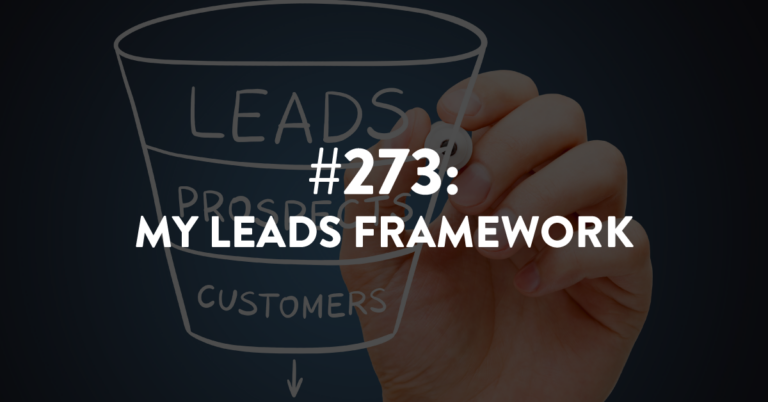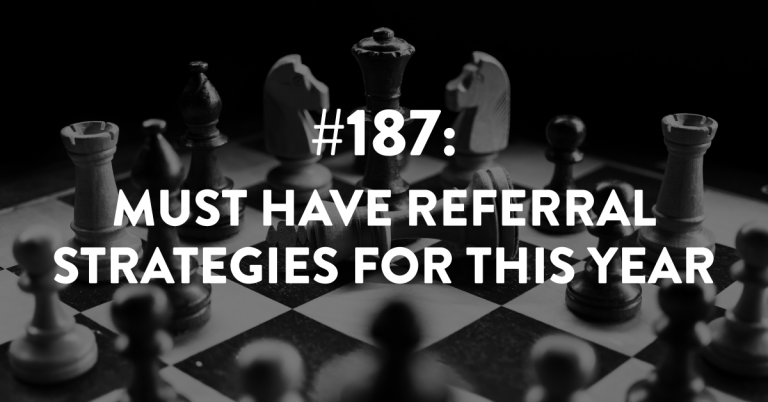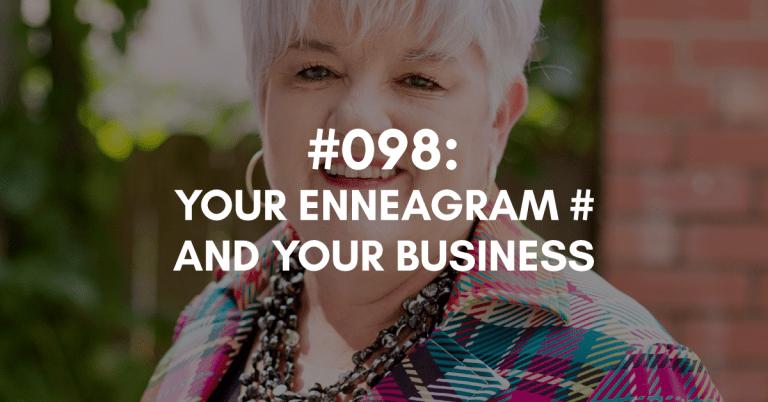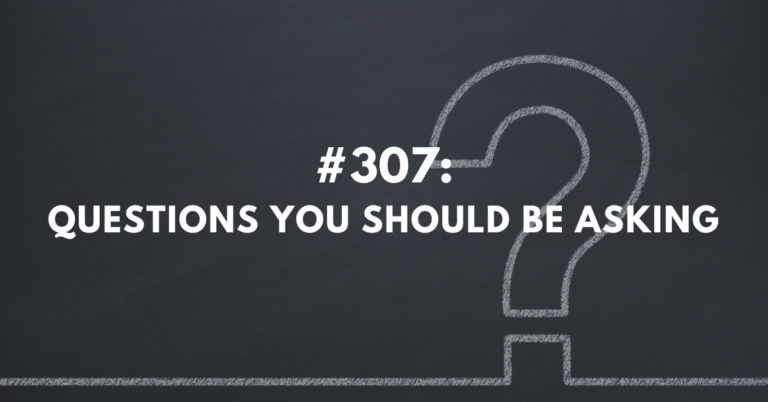Ep #229: The Best Way to Give a Referral
We often talk about how to get referrals, but what about giving them? Generally speaking, what we put out into the world is what we get in return. This means that when we are focusing on getting referrals, we should also be considering giving them—not to everyone you work with, but at least a few individuals that you truly believe deserve it.
This begs the question: do you know how to give referrals the proper way? Here’s how you should give a referral:
#1. Always connect the person you are helping to the person who can help them via email. If email isn’t possible, then use a text thread.
#2. State the reason for the connection. Your business buddy needs a new website, or bookkeeper, or to improve their messaging and copy. Say that in the message to both parties.
#3. If you know the prospect’s timeline and you have permission to share it, please do. It sets everyone’s expectations for whether this is a rush job or something that will happen down the road.
I also cover a few “no no” during the episode too so check them out.
Armed with this information, you are now ready to start giving—or keep giving—the best referrals!
Links Mentioned During the Episode:
Gratitude in Action Challenge – BINGO style!
What’s Coming Up:
Our Gratitude in Action challenge runs all month long! This is our 3rd year with the GIA challenge and this year we are mixing it up… by playing a little Gratitude BINGO? Your mission if you choose to accept it – spread Gratitude all month long to small business owners while aiming to get as many BINGO wins as possible. To download your BINGO board – go to www.staceybrownrandall.com/thanks.
Looking for Referral Resources:
Take the Referral Ninja Quiz to test your skills and abilities at generating referrals. (FREE)
Buy my book – Generating Business Referrals Without Asking – and learn how to generate referrals through my 5 steps. (LESS THAN $16)
Check out our free resources on our Freebie Page. We have broken the free resources into two sections, based on if you have less than 5 referral sources (usually businesses in business less than 2 years) or if you have more than 5 referral sources. Enjoy!
Consider joining Building a Referable Business™ – a unique way to learn all of my referral strategies and tactics with ongoing weekly access to me to answer your questions and help hold you accountable! Check it out and submit your application today!
Next Episode:
Next episode is #230, and it’s time for another Q&A episode on referrals with listener-submitted questions!
Download The Full Episode Transcript
Read the Transcript Below:
Stacey Brown Randall: Did you know there’s a right way and a wrong way to give a referral? Actually, you probably know that, especially if you’re a longtime listener of this podcast. At least, I hope so.
But do you know what not to do when giving a referral? We’ll talk about it all on today’s episode.
Hey there, and welcome to episode 229 of The Roadmap to Grow Your Business Podcast, a show about helping you build a referable business, because you’re worth it. I’m your host, Stacey Brown Randall.
Do you give referrals? I know I talk a lot on this podcast about receiving referrals, and the things we need to do so that others; clients, contacts, et cetera, will give referrals to us.
So, I talk a lot about receiving referrals, but what about giving them?
Now, this episode is by no means meant to convict you, but think about it; what we put out into the universe is usually what we get in return. Not always in direct proportion — sometimes more, sometimes less, and not exactly one for one from the people, but just in general.
Now, of course, I teach proven strategies to generate more referrals, and I love it. This is what makes me love my business and working with you guys.
But what helps, in addition to those proven strategies to generate more referrals, what helps is also giving referrals. Not to everyone you know, not to all your referral sources, because the truth is that’s not possible.
You probably don’t have enough people to refer to everyone you know, and quite possibly, you may not even be able to refer people to the people who refer to you, meaning you may not even be able to refer to your referral sources. Happens to me all the time.
But then there are also people I refer to who are not able really to refer back to me. It’s okay. It’s all part of how it all works together.
So, even though you’re not going to be able to give referrals to everybody you know, and everybody you wish you could give referrals to, including even all of your referral sources. We’ve still got to be focused on giving them, and in particular, being on the look out to be able to give them.
And that begs the question; do you know the right or proper way to give a referral? If you’ve wondered even in the slightest, “Ooh, do I have this right? Am I giving referrals in the right way?” Here’s how you should do it.
Hey there, pardon the interruption real fast. I just wanted to make sure you were aware of our Gratitude In Action challenge that runs all month long this month.
This is our third year with the Gratitude In Action Challenge, and this year we’re mixing it up, interested in playing a little gratitude bingo? Your mission, if you choose to accept it, is to spread gratitude all month long while aiming to get as many BINGO wins as possible. Up and down, left to right, diagonal the whole BINGO board.
You’re going to pick a daily challenge, make it happen. Mark the square once you’ve done it, and then keep going all month long, to download your BINGO board and spread gratitude in the small business community. Spread gratitude all month long. You’ve got to download your BINGO board.
So, go to staceybrownrandall.com/thanks. That’s T-H-A-N-K-S. And you know Stacey has an E.
Okay, here’s how you should give a referral. Just a few things that I want you to avoid as well; not many, but let’s dive in.
When you’re giving a referral, I always want you to connect the prospect. That’s the person you’re helping who has a problem and needs to be referred to somebody else, to some solution provider, to some expert, to some company, usually to a human in that company, let’s be honest.
So, I want you to always connect the prospect, the person you’re helping, who has a problem, to the person who can actually help them. I refer to that as the solution provider, and I want to make sure when you’re always connecting them, you’re doing it intentionally, which means, in this case, via email.
Now, if email isn’t possible, then definitely connect them via a text thread.
So, a lot of people are like, wait a minute, I’ve got to take the person who has a problem, and in this case, it’s actually your friend who has a problem, but will be known as the prospect, to the person you’re about to refer them to.
So, you’ve got to take the person you know as a problem, and then I want you to connect them via email or text to the person who can solve their problem, that business owner who can solve their problem, I want you to make that connection, but I want you to do it in a way that the trust is more powerful as part of the transfer.
And the way that we make that trust more powerful for that solution provider is that we’re actually connecting the prospect, your friend, with the solution provider, the person who can solve the problem, and you are staying involved at least in that initial connection, which is why I want it to happen over email.
And again, if email’s not possible, you can always start a group text thread. So, just think this through in terms of … think about it on the reverse. The best referrals you receive, they drop into your inbox, and it’s usually somebody connecting you to a prospect, and they’re like, “Hey, I am making this connection.”
I want you to do that in writing. That’s the big piece, in writing. So, do it over email, and if you can’t do it over email, do it over a text thread because that trust continues to be transferred.
Each time your friend is looking at that email or starting the communication with the person you just referred them to, they’re going to always see your name and that trust piece will be there, and they’ll remember why they’re being connected to this person they may end up hiring.
Okay, the second thing I want to make sure that you do, is I want you to state the reason for the connection. Your business buddy needs a new website, or they need a new bookkeeper, or they need to improve their messaging and copy, whatever that is. If you have a friend, a business buddy that has a problem, you need to state that problem when you’re making the connection.
It could be that your friend needs to finally hire a financial planner or an interior designer, so they’ll stop complaining about their really bad kitchen. I may be saying that from personal experience. Or they need to be connected to the right real estate agent that you happen to know and love.
But when you make that connection over email or text, you need to say why. Say it in the message to both parties; “Hey Denise, I am connecting you to Steven and here’s why.” Or “Steven, meet Denise — Denise, meet Steven.”
And then you can say a little bit about them and then say why you’re actually connecting them. But you need to state the reason for the connection. Don’t leave anyone hanging, we don’t want to leave anybody hanging, okay?
So, make sure you state the reason for why you’re making the connection in that message to both parties.
Now, more than likely, you’ve probably talked to each of them, or at least to your friend, who you’re going to refer to someone else. You’ve probably talked to them to the point that they realize this referral connection, it’s coming, this usually isn’t a surprise.
And so, in that case, your friend that you’re referring to that business owner, they’ll know, “Oh, this is coming because I said yes, I’m open to it.” But it’s always still good to say why because we get busy and we forget the things we talk about like 12 minutes ago. I know my children do. So, I know we as humans do that, we can forget the thing we had a conversation about a month ago, a week ago, even a day ago.
Okay, and the third thing I want you to do when you’re giving a referral is if you know the prospect’s timeline and you have permission to share it, please do.
So, if you know the prospect’s timeline of making this investment, or hiring this person, if you know their timeline of how they want to do this and what the timeline looks like to make this investment or hire this person or buy this product, then state that in the message when you’re making that email connection.
State the prospect’s timeline in the message, because it sets everyone’s expectation if this is going to be a rush job or if this is something that’ll happen down the road. Both, in my opinion, are really respectful to the business owner who’s going to be receiving this referral and recognizing how they need to kind of respond based on the expectations.
And it is also really fair for the prospect, for that to already be stated on their behalf of, “Hey, if this is further out, like let’s just go ahead and acknowledge it and let’s take some of the pressure off.”
Like, hey, this is something they want to do first quarter of 2023. Great, we all know that now. Or, hey, they need to get their kitchen done by Christmas to every interior designer listening to this podcast, just busted out laughing, knowing it’s November 1st.
So, if it’s supposed to be some kind of rush job, then that’s known as well. It sets the expectation and I think manages the expectation for not only the prospect having the timeline kind of understood, but also, for that person who’s going to respond, and they can understand what they’re actually being referred to, to the situation and what that looks like.
Now, you won’t always have permission to share the prospect’s timeline, that’s totally fine. But if you do, it’s always good and everybody has a better experience because of it.
So, those are the three things I want you to do when you were making the right or proper referral. Always connect the prospect to the person that they need to hire the solution provider in writing, meaning via email or text.
To always state the reason you’re making the connection. “Hey, my friend needs this and this is why I’m connecting you.” And if you know the prospect’s timeline and you have permission to share it, include that as well.
So, here’s just a couple of things that I don’t want you to do. Number one, don’t give the solution providers contact information to the prospect. Don’t just hand them their card or say, “Hey, here’s their contact information.” Send them their contact card over text because that’s going to get lost in a paper trail or in the other 7 million text messages that person’s probably going to receive in the next 72 hours.
So, instead of just giving your friend, “Hey, you need a new financial advisor? Here, let me give you David’s information.” Or, “Hey, you need a new real estate agent? Let me give you Melissa’s contact information.” Don’t just give them the contact information, connect them to each other instead.
And the next thing is, don’t be vague as to why you’re connecting the two parties together. Somebody has a problem, it’s okay to stake that in the email. That should be the whole point of making their referral, and the prospects should be on board with that.
If they’re open to solving the problem that they have, they should be open to the idea that you’re going to connect them to the person that you think can solve it, so they can start the dialogue.
It doesn’t mean they’re necessarily always going to hire the person that you’ve referred them to, but we need to make sure we know why we’re connecting the two parties together, it helps everybody have a better experience.
And if your prospect friend is serious about solving their problem, whether that is getting a new website finally going, or getting those new headshots done, or finally selling their second house because they never go visit it; whatever it is, if they’re finally ready to decide, I’m going to do something about this problem, then they should be ready to talk to someone about it when they agree to you to refer them to someone.
Which means also (and here’s the third thing), if you’re the one being referred … so, okay, I’m a slightly off topic here, but it’s just my soapbox for a second. If you’re the person being referred, like you’re talking to a friend, you’ve got a problem, you’re interested in solving it, they say, “Oh my gosh, you have to talk to Stacey.” Or, “Oh my goodness, you have to talk to Megan.”
And they’re like, “Great. Please connect me with Megan.” And then they connect you with Megan, can you do me a favor? Can you not ghost Megan? Like you were all on board for that connection to happen.
So, when Megan reaches out and be like, “Oh my gosh, it’s great to meet you. I’m so glad you were referred to me, happy to talk to you, if I can help solve your problem.” When Megan reaches out with that language, can you please not ghost her? That would be amazing.
That doesn’t mean you need to hire her. You’re under no obligation to, you’ve got to make the right decision for yourself or your business, depending on what product or services you’re considering purchasing or investing in.
But if somebody goes through the trouble to refer you to someone else, please don’t ghost them, like just follow up. And if something’s changed, it’s okay to say that. We’re all grownups.
Sorry, I couldn’t help myself. Okay, now, you know, and you are ready to start giving or keep giving the best kind of referrals because you know the three things to do and the couple of things not to do.
If you need to find anything that we’ve discussed in this episode, it is always on our show notes page. Every single episode has a show notes page, and you can find this one at staceybrownrandall.com/229. That’s for episode 229, and everybody said together — and Stacey has an E.
Real quick reminder, the third annual Gratitude and Action Challenge that we do every November is coming up. It’s here actually, are you interested in playing a little gratitude BINGO? Your mission, if you choose to accept it, is to spread gratitude all month long while aiming to get as many BINGO wins as possible. You win and the person you’re giving gratitude wins as well.
Now, this challenge is focused on our small business community. All types of small businesses; online, brick and mortar, service providers, product providers, doesn’t matter. We love small businesses, and we are going to show them some gratitude this month.
So, get ready to spread some small business gratitude BINGO style. To download your BINGO board, please go to staceybrownrandall.com/thanks. And of course, that link will be on the show notes page for this episode as well.
Oh, and if you do sign up and you decide, yeah, I’m going to do some BINGO, some Gratitude In Action BINGO. If you do decide to sign up, will you let me know about it?
Tag me in a social media post. Most places I’m at Stacey Brown Randall, but tag me in a social media post with the hashtags, @gratitudeinaction and #gratitudeBINGO.
Coming up next week is episode 230, and it’s time for another question-and-answer episode with our listener submitted questions.
So, if you’ve been a longtime listener to this podcast, or you’ve at least listened to the last couple of dozen episodes, you know typically every 10th episode I take listener submitted questions and I answer them.
So, if you ever have any questions you want me to answer and you really want to hear that verbal response, first, it’s just a typed-out response in an email or that you’ll see in social media, in particular in our Referrals Without Asking Facebook group.
If you really want to hear that verbal response from me, then you got to submit a question and we will answer it on an upcoming Q&A episode. And we have one coming up next week.
You know what to do until then my friend, take control and grow your business. Bye for now.
Thanks for listening to the Roadmap to Grow Your Business podcast. To
access all resources and links mentioned in today’s show, and to
connect with Stacey, head over to www.staceybrownrandall.com.

